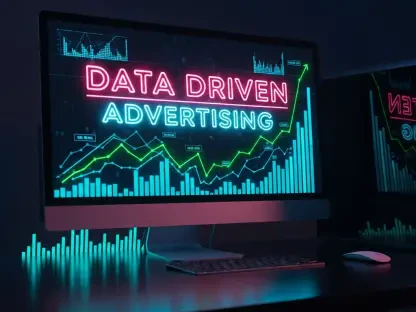In the fast-paced realm of digital advertising, staying ahead of technological advancements is not just an advantage but a necessity, especially when automation and AI are reshaping how campaigns are built, optimized, and scaled at an unprecedented rate. The release of Google Ads API v22 has sparked significant buzz among marketers and developers for its promise to revolutionize advertising efficiency through cutting-edge features. This roundup dives into a collection of opinions, tips, and reviews from industry professionals to uncover how this update is transforming ad campaign management. The goal is to provide a comprehensive perspective on its innovations, challenges, and practical applications for advertisers navigating an increasingly automated landscape.
Unpacking the Hype: What Industry Voices Say About Google Ads API v22
AI-Driven Asset Creation: A Game Changer or a Risky Bet?
Industry feedback on the AssetGenerationService, a beta feature in Google Ads API v22 that uses generative AI to produce text and image assets, reveals a mix of excitement and caution. Many digital marketing specialists highlight the potential for massive time savings, noting that automating content creation can cut down hours of manual work. Some have shared that early testing showed a noticeable reduction in asset production timelines, allowing teams to focus on strategy over execution.
However, not all opinions are unanimously positive. A segment of professionals expresses concern over the consistency of AI-generated content, pointing out that quality can vary and may not always align with brand voice. There’s a shared sentiment that while the tool offers efficiency, it requires rigorous oversight to ensure outputs meet campaign standards, sparking debate on whether the benefits outweigh the need for constant monitoring.
Another angle brought up in discussions is the challenge of integrating this AI tool into existing workflows. Several tech consultants emphasize that without updated training for teams, the adoption of such advanced features might lead to errors or underutilization. This diversity in feedback underscores a broader question: does this innovation simplify processes, or does it introduce new layers of complexity?
Smart Bidding Enhancements: Precision or Over-Automation?
The updated Smart Bidding capabilities, particularly for Target ROAS strategies in Search campaigns, have garnered attention for offering time-segmented diversity metrics. Marketing analysts commend this feature for enabling real-time bid optimization, with some citing examples where advertisers achieved better ROI by leveraging granular data insights. The consensus among many is that this level of precision empowers data-driven decisions like never before.
On the flip side, a portion of industry feedback warns against an over-reliance on automated bidding tools. Experienced campaign managers argue that while the metrics are valuable, they can sometimes lead to decisions that overlook broader market dynamics if not paired with human judgment. This perspective stresses the importance of maintaining a balance between automation and strategic input.
Additionally, differing views emerge on the learning curve associated with these enhancements. Some professionals note that smaller teams or those less familiar with API-level adjustments might struggle to maximize the feature’s potential without dedicated resources. This split in opinions highlights a critical need for accessible training or support to ensure all advertisers can capitalize on these advancements.
Campaign-Specific Updates: Diverse Opinions on Effectiveness
Demand Gen and Performance Max: Automation for All Markets?
The automation upgrades for Demand Gen campaigns and API-level enhancements for Performance Max, such as image extraction and improved reporting, have elicited varied reactions. Many global marketing strategists praise these updates for addressing diverse market needs, especially in regions with fluctuating demand patterns. The ability to automate asset generation and access detailed reporting is seen as a boon for scaling campaigns efficiently across different scales.
Contrastingly, some experts question whether full automation truly simplifies campaign management for niche strategies. Feedback from specialized advertisers suggests that while these tools streamline broad campaigns, they can complicate efforts tailored to specific audiences due to a lack of granular control. This critique points to a potential gap in customization that might not suit every advertiser’s goals.
A third perspective focuses on adoption trends, with consultants noting that larger agencies are quicker to integrate these updates compared to smaller firms. This disparity raises discussions about whether the benefits of automation are universally accessible or skewed toward those with more robust technical infrastructure. The conversation continues to evolve as more data on global implementation emerges.
App Campaigns for Installs: Flexibility Meets Skepticism
The flexible bidding goals introduced for App Campaigns for Installs (ACi) in Google Ads API v22 have sparked interest among app developers and growth marketers. Many applaud the adaptability of optimizing without rigid targets, seeing it as a significant shift from traditional methods that often constrained rapid scaling. Feedback suggests this feature aligns well with the needs of advertisers in dynamic, fast-growth sectors.
Yet, not all reviews are glowing. A number of industry veterans express skepticism about the long-term effectiveness of such flexibility, arguing that undefined goals might lead to inconsistent performance tracking. They advocate for combining this approach with clear benchmarks to avoid aimless optimization, reflecting a cautious stance on abandoning structured targets entirely.
Another insight comes from tech integration specialists who emphasize the importance of aligning this flexibility with broader industry trends toward customization. They suggest that while the update offers freedom, its success depends on how well advertisers adapt it to specific campaign objectives. This variety of opinions paints a picture of opportunity tempered by the need for strategic clarity.
Key Takeaways and Practical Tips from the Community
Drawing from the wealth of insights shared by industry professionals, several core benefits of Google Ads API v22 stand out, including AI-powered asset creation, precise bidding strategies, and tailored campaign enhancements. A common tip echoed across discussions is the urgency of updating client libraries promptly to access these features without disruption. Leveraging Google’s migration guides is also frequently recommended for a smooth transition.
Another actionable piece of advice centers on testing new tools like the AssetGenerationService in controlled environments before full deployment. Many experts suggest starting with small-scale campaigns to gauge AI output quality and integration challenges. This approach helps mitigate risks while building familiarity with the technology.
Lastly, a recurring theme in community feedback is the value of adjusting bidding strategies iteratively using the new metrics provided. Marketers are encouraged to analyze time-segmented data regularly and balance automation with manual oversight for optimal results. These practical steps provide a roadmap for advertisers aiming to harness the full potential of this update.
Reflecting on the Discussion: Steps Forward for Advertisers
Looking back on the diverse perspectives gathered, it becomes clear that Google Ads API v22 has sparked both enthusiasm and critical analysis among industry professionals. The blend of groundbreaking AI tools and enhanced campaign features offers a glimpse into the future of advertising efficiency, though challenges in quality control and accessibility remain points of contention. The dialogue illuminates how automation reshapes workflows, often for the better, but not without hurdles.
Moving forward, advertisers are advised to prioritize ongoing education on API updates to stay competitive in an ever-evolving digital space. Exploring additional resources, such as community forums or official documentation, is seen as a vital next step to deepen understanding. By actively engaging with these tools and sharing insights, the advertising community can collectively refine strategies and overcome initial adoption challenges, paving the way for sustained innovation.








